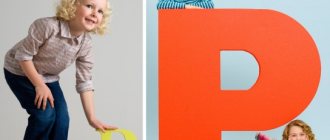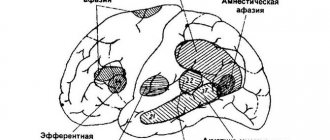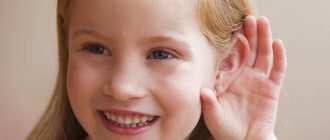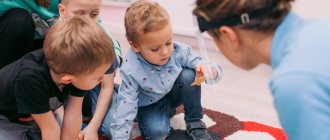Psychological and neuropsychological assistance
Sensory integration is a method of working with a child, during which the central nervous system (brain) processes all the information sent by the body’s various sensory systems (vision, hearing, touch, taste, smell, balance (vestibular apparatus), perception of one’s own body and transforms sensations into perception, i.e. organizes them for movement, normal behavior and learning.
An intervention based on sensory stimulation and integration - correctional work based on play in a special developmental (therapeutic) environment. This environment provides gentle contact with a variety of sensory stimuli.
The specialist closely monitors the child and provides him with a wide range of activities that meet his sensory needs and interests.
During this work, the brain's reaction gradually changes, and the child's central nervous system begins to better evaluate the information received and better use it in everyday life.
As a result, motor (motor) reactions associated with coordination of movements, breathing, speech, behavior, learning and others are improved. And this, in turn, leads to changes, the result of which is improved thinking and social functioning, adaptation to the environment.
Sensory integration is corrective and developmental at the same time, it is aimed at improving thinking and social functioning.
The Sensory Integration program is developed based on the methodology of E. Jean Ayers on the organization of sensations for practical activities.
The technique is based on an understanding of the neurological processes that organize human sensations coming both from inside his body and from the outside, from the environment. Based on the understanding of these processes and the integration of their activities, the E. Jean Ayers methodology was developed, on which the program is based.
The program involves the correction of sensory integration disorders:
- motor clumsiness
- fast fatiguability
- refusal of social contacts
- speech development delay,
- motor development,
- learning difficulties,
- poor organization of behavior,
- hyperactivity,
- attention deficit disorder or excessive calmness,
- lack of any motivation or activity
The technique includes the following exercises and activities:
- A set of game activities aimed at balance in behavior and perseverance when studying at school.
- Movement exercises to improve coordination of movements.
- Integration of the vestibular system, including decreased or increased activity of the vestibular system.
- Work on maintaining balance, stability when moving, coordination of movements.
- Elimination of internal causes of motion sickness when moving.
- Integration of movements, planning and correct reaction. Interaction with the environment.
- Working with types of activity disorders.
- Working on movement control.
- Work on reactions related to the position and preservation of the body in space, a certain pose.
- Working with disorders of specific motor skills.
- Working with motor planning disorders.
- Development of stable patterns of planning motor skills. Skills and habits.
- Normalization of perception and processing of sensations by the child’s central nervous system received from skin receptors (reduced sensitivity or, conversely, tactile hypersensitivity).
- Autism spectrum disorders.
- Work with the registration of sensory signals (impulses) when their processing by the central nervous system is disrupted. Apraxia.
- Modulation of sensory impulses. Work on regulating excess activity.
- Development of motor planning.
What is sensory integration?
This is a process in the central nervous system that causes various sensations in a person: tactile, sound, visual and many others. Thanks to this, a person feels himself in the environment and can function effectively in it. In other words, this type of integration represents the ability of the human brain to receive stimuli from the senses and successfully analyze them.
In the human central nervous system, multiple processes associated with the sensory organs occur every second. They need to be processed and reacted in one way or another. But not everyone has the ability to do this quickly and correctly. As a rule, young children experience difficulties. First of all, this applies to premature babies, as well as those who spent the first years of their lives in an orphanage or have developmental disorders.
Sensory Integration Method
The sensory integration method was developed by pediatric neurologist and occupational therapist J. Ayres in the 70s of the twentieth century in the USA. Currently, the method continues to develop and is successfully used throughout the world for the prevention and treatment of developmental disorders.
The method is based on the idea of the holistic functioning of the human nervous system. One of the central processes that occurs in the nervous system is the reception, processing and integration of information that comes from all senses. In addition to the five senses known to everyone - vision, hearing, touch, smell, taste - there are two more. These two channels of sensation play a decisive role in the development of the child. These are vestibular sensitivity (sense of balance) and proprioception (sensation of muscles and joints). Together with tactile perception (touch), they create a holistic idea of one’s own body. Based on this idea, a person is able to manage his behavior adequately to the situation.
A delay or disruption in the processing of information from one’s own body leads to a distortion of psychomotor and speech development. This causes difficulties in the child’s behavior and learning: the child may be awkward, have insufficient control of his own body, have a delay in the formation of fine motor skills and speech, avoid some sensations and obsessively reproduce others, be overly tired and emotionally excitable.
Thanks to special diagnostic tests, a neuropsychologist or sensory integration specialist can determine whether a child has information processing disorders and create a specific, individual plan for developmental or correctional activities.
The sensory integration method is based on a playful approach - for a child, the activity looks like a game. The lesson is held in a hall with special equipment for the development of all types of sensitivity and motor coordination. The hall contains various swings, balance beams, suspensions, special balls, sports and therapeutic equipment. The specialist selects those types of activities that may interest the child and at the same time give the maximum developmental and therapeutic effect. The specialist also gives recommendations to parents on how to equip their home environment and how to study at home in order to consolidate the results of their studies.
Classes using the sensory integration method solve the following problems:
- assistance in regulating the child’s condition (activation if the child has reduced general tone, or reduction of excitability if the child is prone to excessive general arousal);
- stimulation of speech development (due to the activating influence of the vestibular system on speech zones);
- development of large and fine motor skills, coordination, balance;
- working with some fears: “spatial” (for example, fear of heights) and related to the body (for example, fear of washing your hair, etc.);
- strengthening of voluntary regulation of activity and attention (the ability to plan one’s actions and consistently implement what is planned).
Classes can be conducted for 30 or 50 minutes, individually or in a mini-group. Recommended course – 15 lessons.
Sensory integration - a modern method of child development
Every day, every person on the planet uses the anatomical and physiological system of their body, incl. sense organs - hearing, vision, taste, smell, touch and vestibular apparatus. It is important to note that each action is first processed by the brain, then the signal is transmitted to the nervous system, which is responsible for performing simple and complex reflexes. Of course, all these processes can be controlled and need to be developed. There is a special direction for this – sensory integration (SI).
Sensory integration: what kind of technique?
Many parents, having heard about SI, ask the question: “Sensory integration - what is it?” We answer and tell you in detail.
Sensory integration (from the Latin “sensus” - sensation, “integratio” - restoration) is a specific process during which the nervous system receives information from the receptors of the sensory organs and, analyzing them, uses them to perform purposeful activities. This is a kind of ability of the nervous system to productively bring together information coming from different channels. The success of a person’s activity as a whole largely depends on how developed this ability is. Therefore, it is important to develop it with the help of special classes on sensory integration. The result of such activities is correct sensorimotor development and instant reflexes to external stimuli.
Conventionally, sensory integration “forces” the brain to perceive information from receptors (and respond to it) faster; accordingly, the processes of reproducing various functions are accelerated.
The possibilities of sensory integration were first described by the American occupational therapist, psychologist and teacher Anne Jean Ayres. She presented the developed methods based on the sensory-integrative approach in 1963 at the University of Southern California as part of her dissertation in educational psychology. Since 1976, Ayres has been exclusively practicing her findings in the field of sensorimotor development, with the help of which she has provided assistance to children with various sensory disorders. Today this method is used all over the world and helps children overcome motor awkwardness and restore the “receptor-reflex” balance.
Who conducts these classes?
Sensory integration is, first of all, work with brain functions, so most often classes using sensory-integrative techniques are conducted by neuropsychologists and defectologists who have undergone additional education in this area. It is possible to say more precisely who will work directly with your child only after diagnostics have been carried out and specific violations have been identified as a result. The program for the restoration and/or development of sensorimotor functions is selected individually; For each child, these are different games and activities aimed directly at the area that is more difficult for him. It is important that the use of sensory integration does not force the child to perform difficult actions; on the contrary, the use of game mechanics is captivating and interesting, and simply affects the same areas of the brain that are responsible for actions that are difficult for a particular child.
Sensory integration disorders in children: examples of such disorders
Sensory integration disorders are called dysfunction and present various problems of auditory, visual, tactile, gustatory, motor, olfactory and coordination. Symptoms of sensory integration dysfunction most often manifest themselves in emotional lability, behavioral factors, motor function, delayed speech development, which subsequently leads to problems in educational activities, social adaptation, concentration and the formation of self-control.
Sensory integration dysfunction is usually complex, i.e. when disturbances manifest themselves in the functioning of several sense organs. However, there is also narrowly targeted dysfunction. What should you pay attention to, and how do sensory integration disorders manifest themselves?
From the auditory function:
fear of loud sounds and noise, intolerance to certain types of music or music in general, negative reactions to singing/voice, unresponsiveness to calls, confusion in crowded and public places.
From the visual system:
photophobia (preference for twilight and darkness), tension when looking at objects, clumsiness when going up and down (for example, on steps), does not look into the eyes of the interlocutor.
From the tactile function:
refraining from playing with plasticine, dough, paints, small objects, reducing pain and temperature sensitivity, do not tolerate being touched. They have a negative reaction to certain types of fabric/clothing; they do not like to walk barefoot.
From the vestibular apparatus:
clumsiness and clumsiness of movements, instability, negative manifestations of active games, playgrounds and sports, muscle tone, problems with concentration and coordination, excessive anxiety.
From the taste and olfactory systems:
food sensitivity (refusal of certain types of foods), decreased taste buds, negative reaction to odors, poor sensitivity to odors.
If several disorders from the above symptoms appear, it is necessary to contact a specialist and conduct a diagnosis for sensory dysfunction.
Sensory integration for a child who won't speak
Sensory integration and speech have a very close relationship. Sensory integration dysfunction is one of the common causes of SRD (speech development delay), which is why classes using sensory-integrative techniques are recommended for children who have speech difficulties. Thus, to initiate speech, games aimed at developing fine motor skills are used: busy boards, “dry” pools, games with cereals, sand, etc. In the halls for sensory integration classes, all conditions are created for maximum immersion of the child in an exciting play environment. It is believed that sensory integration is one of the most effective ways to start speech as quickly as possible.
Using sensory integration for ADHD, ASD, autism
Sensory integration disorders arise as a result of the following reasons: — Genetic predisposition — Pathologies of intrauterine development/intrauterine infections — Birth injuries — Pathologies in the newborn/infancy period — Environmental factors (ecology) — Neuropsychological development disorders — Traumatic brain injuries — Cerebral palsy (CP) - Autism spectrum disorder (ASD) - Congenital autism And also as a result of attention deficit hyperactivity disorder (ADHD). It is important that sensory integration dysfunction is almost always detected in autism, ASD, cerebral palsy, and brain damage (for example, traumatic brain injury); often - with ADHD. For ADHD, ASD, cerebral palsy and autism, comprehensive classes with sensory integration are necessary in 100% of cases, because are one of the effective methods for the development of higher mental functions of children with impaired brain activity and damage to the cerebral cortex. For each child, a sensory integration program is developed individually, taking into account the abilities and characteristics of a particular child.
It is worth noting that sensory disorders occur in 20% of all preschool children and require the active introduction of sensory integration into the child’s life.
Where and how are sensory integration classes taught?
Typically, sensory integration classes are conducted by specialists in children's correctional and development centers. A separate room is allocated for this type of activity. The hall is equipped with various game-type objects, interaction with which has a positive effect on the development of brain functions.
What does the sensory room include?
— Various hammocks, mats, balance beams, rocking chairs in different shapes (log, platform, barrel, cube, ball, etc.). — Various types of wall bars, complexes with a sports and gaming focus.
— “Dry” pools, water mattresses and trampolines.
— Rope tunnels and sensory walking paths.
— Trays with various objects for the development of fine motor skills (sand, cereals, balls, etc.).
— Busy boards, busy cubes, busy houses.
— Weighted blankets and pillows.
— rustling objects, bright (of different colors and shapes).
— Educational mats and tables.
— Lighting and sound equipment, etc.
It is unlikely that you will be able to create such a room at home on your own due to the large number of large objects for classes. Moreover, most of the equipment is quite expensive.
Experts' opinions on the technique
Sensory integration for children is recognized throughout the world and is considered the most effective method for developing brain function. Every year, SI is gaining increasing popularity in developed countries due to the pronounced positive dynamics of children studying using this method.
It is almost impossible to find negative opinions about sensory integration even on the Internet - they simply do not exist. Various specialists from the field of psychology, speech therapy and defectology try to use a sensory-integrative approach in their classes.
“Classes using this method are effective for the development of a child’s speech, the formation of more mature self-regulation, self-control of behavior and for overcoming motor difficulties,” says A.V., head of the Altera Vita Center for Child Neuropsychology. Suntsova.
It is worth noting that usually SI comes in combination with the main correction (for example, neurocorrection, defectology or speech therapy). The most effective age for such activities is considered to be delta from 2 to 12 years. Of course, the younger the child, the faster parents will see positive dynamics. That is why it is very important to respond in a timely manner to the developmental characteristics of your child and the symptoms of possible disorders in order to diagnose the problem as early as possible and begin activities that always give visible results.
In Moscow, sensory integration classes are possible in many children's centers, incl. at the Altera Vita Center for Pediatric Neuropsychology.
www.Logopedy.ru
Authors: Belova Elena Vladimirovna - teacher-defectologist,
Raskatkina Elena Nikolaevna – teacher-speech therapist,
Kuznetsova Nina Arkadyevna - teacher-defectologist,
MBDOU combined type No. 45, Arzamas city, Nizhny Novgorod region
Original:
The main component of the full development of children is the development of sensory integration.
Sensory integration is the interaction of all senses. It begins very early, already in the womb. The interaction of all senses involves the ordering of sensations and stimuli in such a way that a person can adequately respond to certain stimuli and act in accordance with the situation. For example, sensory integration is observed when we feel the touch of a bug crawling on us, are aware of what is happening and know where it can be swatted. In other words, everything that we receive from the senses (and this is vision, hearing, touch, smell, taste, the sense of movement (vestibular system), the sense of body position in space (proprioception), enters the brain, is processed there, and is given to us in the form of some knowledge about an object - what it is, what properties it has and how dangerous it is for the body or, on the contrary, useful. The more correctly the sensory systems work, the more sufficient information the brain receives and produces more adequate responses.
The interaction of the five senses is sensory integration for preschoolers.
The sensory integration required for movement, speaking, and play is the foundation of the more complex integration that accompanies reading, writing, and appropriate behavior.
“Interesting” is the childish definition of sensory integration.
The creator of the sensory integration method is Jean Ayres , speech therapist, psychologist, occupational therapist, and researcher at the University of Southern California in Los Angeles.
Understanding the world around us begins with sensations, with perception. With the help of sensation, the child learns individual signs and properties of objects that directly affect his senses.
A more complex cognitive process is perception, which provides a reflection of all (many) signs of objects with which the child directly comes into contact and acts. The richer the sensations and perceptions, the broader and more multifaceted the information the child receives about the world around him will be.
It is known that the success of mental and physical education, and mastery of speech largely depends on the level of sensory development of children, that is, on how completely the child hears, sees, touches the environment, how well he handles this information and expresses this knowledge in speech. Sensory development in early and preschool children is closely related to sensory integration.
The process of cognition of a small person differs from the process of cognition of an adult. Adults understand the world with their minds, small children with their emotions. The cognitive activity of a 3-5 year old child is expressed primarily in the development of perception, the symbolic (sign) function of thinking and meaningful objective activity. In the process of developing perception, the child gradually accumulates visual, auditory, tactile-motor, and tactile images.
In this regard, one of the main tasks of children's activities is to develop interest in learning through sensory stimuli. It is necessary to organize children so that they want to do something, so that self-knowledge occurs, and motivation to speak appears.
In order for any concept, its name, to be fixed in the child’s memory, he must see, hear, taste and touch it. And only in this case is this connection formed in the brain. Nowadays there are many children in kindergartens who have some connection or some drop out. If for some reason the integration is weak and the brain cannot receive enough knowledge and give an adequate response, this can lead to problems with speech and general development.
In our preschool, along with ordinary children, children with disabilities are educated. In this category of children, there is an insufficiency in the process of processing sensory information ; often children cannot holistically perceive observed objects; they perceive them in fragments, highlighting only individual signs. All this complicates the process of correction and socialization.
We believe that one of the possible ways to solve this problem is to include elements of sensory integration into the overall system of correctional work.
The method of sensory integration in the work of a speech therapist, speech pathologist and psychologist involves stimulation of all senses and is aimed at activating cognition, all aspects of speech, and correcting behavior through sensory input.
This experiment presents a system of work to enrich children’s sensory experience, create connections in the brain through experimentation, games, subject-based practical activities, and create a specific developmental subject-spatial environment.
In our kindergarten there are 5 compensatory groups. Children have deficiencies in intellectual (developmental disabilities, intellectual disabilities) and speech (allalia, OSD, systemic underdevelopment of speech) development, motor disorders, behavioral characteristics of the autism spectrum, hyperactivity, difficulties in interacting with peers and adults. It is difficult for children to maintain attention on learning tasks, their interest is not stable, and there is often a lack of motivation for development.
In preschool age, great attention is paid to the development of the five basic senses - vision, smell, touch, hearing and taste.
A person receives the bulk of information about the world around him through vision.
Visual perception is a complex job, during which a large number of stimuli acting on the eye are analyzed. The more perfect visual perception is, the more diverse the sensations are in quality and strength, which means the more complete, accurate and differentiated the surrounding world is reflected. Impaired visual perception leads to difficulties in distinguishing objects (size, ratio of parts, differentiation of mirror or similar elements in configuration, etc.). Insufficient development of visual perception leads to a lag in the formation of spatial orientation.
Games that train visual perception develop observation, attention, memory, form an idea of color, shape, size, spatial arrangement of objects, and increase vocabulary.
Games with hiding, searching and finding, based on children's interest in the unexpected appearance and disappearance of objects, help train visual perception. Children are interested in looking for pictures at the bottom, under a thin layer of filler.
Games with sensory aids help to interest, distract, relax the child, ensure the most successful completion of a task, and develop mental and speech processes.
The ability not just to hear, but to listen, to focus on sound, to highlight its characteristic features is an exclusively human ability, thanks to which knowledge of the surrounding reality occurs.
Auditory perception begins with acoustic (auditory) attention and leads to an understanding of the meaning of speech through recognition and analysis of speech sounds, supplemented by the perception of non-speech components (facial expressions, gestures, posture).
The development of auditory perception proceeds in two directions: on the one hand, the perception of speech sounds develops, that is, phonemic hearing is formed, and on the other hand, the perception of non-speech sounds, that is, noise, develops.
Specially selected didactic games make it possible to act on a sound signal, learn to distinguish many objects and objects of the environment by characteristic sounds and noises, correlate one’s actions with signals, etc., and therefore correct deficiencies in auditory perception. At the initial stage, to distinguish non-speech sounds (as well as speech material) require visual, visual-motor, or simply motor support. This means that the child must see an object that makes some unusual sound, try to extract the sound from it in different ways, that is, perform certain actions. Additional sensory support becomes optional only when the child has formed the necessary auditory image.
Games for the perception of sound should give an idea of noises of different nature: rustling, creaking, squeaking, gurgling, ringing, rustling, knocking, birdsong, train noise, cars, animal cries, loud and quiet sounds, whispering, etc.
The development of visual and auditory concentration, attention to speech and its understanding is carried out in the process of the child’s cognition of objects and phenomena of the surrounding reality, i.e. Speech development and the development of the child’s cognitive abilities occur simultaneously. For the successful development of visual and auditory concentration, attention to speech and its understanding, the child must see the object and at the same time hear its name, touch it, smell it / if it has a smell /, try / if the object is edible /, perform some actions with it: hold it in hands, stroke, ride in the car, etc.
Visual and auditory sensations develop when selecting “music”. Children are looking for identical “sounding boxes” filled with various substances. The noise in the box stimulates hearing.
A child cannot develop a comprehensive understanding of the surrounding objective world without tactile-motor perception, since it is this that underlies sensory cognition. “Tactile” (from Latin tactilis) - tactile.
Tactile images of objects are formed through touch, sensation of pressure, temperature, pain. They arise as a result of the contact of objects with the outer integument of the human body and make it possible to know the size, elasticity, density or roughness, heat or cold characteristic of an object.
Games for the development of tactile sensations have a great influence on the emotional sphere and the formation of internal sensations. While playing with “dirty” materials, sensory sensations develop, the child learns to feel the world around him through tactile contact.
With the help of tactile-motor perception, first impressions are formed about the shape, size of objects, location in space, and the quality of the materials used.
The hand is the organ of touch. The completeness and correctness of the image of the perceived object depends on the synchronization of movements of the fingers of both hands, the accuracy and purposefulness of movements, and the sequence of perceptual (examining) actions. Consequently, the development of tactile-motor sensations will be facilitated by “manual” activities, some of which we willingly use in our work:
· modeling from plasticine;
· drawing with fingers, a piece of cotton wool, or a paper “brush”;
· games with large and small mosaics, construction sets (plastic);
· collecting puzzles;
· sorting small objects (pebbles, buttons, acorns, beads, chips, shells), different in size, shape, material;
· games with small pebbles and bulk materials.
In addition, practical activities evoke positive emotions in children and help reduce mental fatigue.
The ability for tactile perception is directly related to the development of fine motor skills of the hands, therefore in our work we use traditional finger exercises, elements of massage and self-massage, which also helps to increase tactile sensitivity.
Self-massage of the hands and fingers in the “sensory box” helps stimulate tactile-motor sensations, normalize muscle tone, and form voluntary, coordinated movements of the fingers. The noise in the box stimulates hearing and visual sensations. The child’s sensory experience (texture of the material) is enriched.
Massage and self-massage are accompanied by a poetic text or performed to music.
Additional information about the surrounding world is provided by smells (stimulation of the sense of smell) and taste (stimulation of the sense of taste). They enrich the child’s understanding of the world around him and fill him with new emotional experiences.
All the odors that surround us can be divided into two groups: pleasant and unpleasant (for example, the smell of the forest and the smell of exhaust fumes; the smell of fresh bread and spoiled meat, etc.).
Within each group there is a huge number of different differentiated smells and aromas.
You can stimulate your sense of smell by changing scents and making them less and less harsh.
Children distinguish the taste qualities of objects by tasting them. Taste sensations are usually divided into salty, bitter, sour and sweet. All complex taste sensations are a combination of basic ones.
The sense of taste develops through stimulation provided by food and drink. When giving your child small pieces of various foods, you need to encourage him to guess with his eyes closed what he is eating (however, you should not give him anything bitter or spicy).
Work to enrich sensory experience is impossible without creating a certain developing subject-spatial environment.
For full sensorimotor development and enrichment of children’s sensory experience, the offices of a defectologist, speech therapist, psychologist, and group rooms are equipped with various stimulus materials aimed at developing the main types of perception:
• Tactile perception; • Visual perception; • Auditory perception; • Olfactory perception; • Taste perception.
The harmony of the combination of various shapes, sizes, textures, colors of objects, the natural qualities of natural materials not only allow children to master new sensations, but also create a special emotional mood.
To develop tactile sensitivity in children, a developing object-spatial environment has been created and periodically replenished, which includes appropriate materials.
In our practice, we use various didactic simulators, games, and aids that serve to develop tactile sensitivity in children.
“Ball baths” or, as they are also called, “dry pools” give positive emotions, relieve stress, fatigue, create interest in activities, and motivate to complete a task. By “bathing” in such baths or putting their hands in them, children receive new tactile sensations. Small baths are located in specialists’ offices, large ones in compensatory groups.
The use of massage balls has a good effect. Balls of different shapes, elasticity, and surface textures provide a wide range of different sensations that can be obtained by handling these objects independently. The use of Su - Jok balls promotes the development of memory and attention, stimulates speech activity.
Massage brushes terry mittens, wheel massagers, and massage rollers of different shapes, elasticity, and surface textures
Whenever possible, in our work we use the natural conditions of the natural environment: games with small pebbles, cones, tree fruits (acorns, chestnuts)
In the psychologist’s office there is a sensory aid “Dry Shower”. This manual stimulates tactile sensations, helps the perception of space and your body in this space, and helps relieve emotional stress.
Double-sided tactile panel “Herringbone” - designed to stimulate tactile sensations and tactile skills. Various tactile objects and materials that develop fine motor skills are attached to both sides of the panel.
Didactic manual Tactile box is designed for games and development of a child’s logic, imagination, and memory. With the help of the product, the child trains fine motor skills and tactile skills, learns to correctly correlate the sizes of objects, and learn colors.
The tactile complex “Sun” is a set of 11 modules, each of which has a different carpet covering. The complex is designed to stimulate children's tactile sensations of the feet, development of balance and motor skills. This manual is in a group; specialists use individual elements.
Along with the developmental aids described above, in our work we use various didactic games and exercises, such as: “Wonderful bag”, “Touch and blind”, “Cold-hot-warm”, “Fun massage”, “Remember the object” , “Find a Pair”, games with mosaics, puzzles, soap bubbles, water and others.
Thus, through repeated sequential implementation of practical exercises on developmental aids and equipment, an increase in tactile sensitivity in children is achieved.
The creation of a subject-spatial environment for the development of visual perception contributes to the construction of a visual image of the world based on sensory information obtained through the visual system.
The game set “Froebel's Gifts” is a unique set of educational materials created for the development and education of the individual. Using a play set develops children's ability to observe, spatial thinking, and sensory perception.
The magnetic set “Landmark” is a manual intended for corrective work on spatial orientation, promotes the development of the ability to receive, analyze and verbally describe information about the surrounding space in practical orientation.
The interactive panel “ Sun ” is a touch-screen gaming terminal with colorful interactive games for children, developed under the leadership of Lyudmila Borisovna Baryaeva. Multifunctional gaming material allows you to develop visual perception, sensorimotor and cognitive abilities of children.
Large and small sensory didactic tables help improve children’s sensory and visual perception, develop fine motor skills, concentration and coordination of movements.
Mosaic table - a new version of the favorite mosaic game. Promotes the development of color perception, visual and auditory concentration, trains fine motor skills of the hands, develops imagination, imaginative thinking. Located in the group room, it is used in individual and subgroup work by specialists and educators.
The Maze Wheel game panel promotes the development of visual perception, voluntary attention, perseverance, logical thinking, fine motor skills and hand coordination.
The child’s task is to guide the ball from the starting point of the maze to the final point in the least amount of time.
Decorative and educational panel “Seasons” - promotes the development of visual perception, forming ideas about the changing seasons. When learning about the seasons, ask children to draw a tree in winter (with all the leaves removed), spring (with flowers on), summer (with flowers and lots of leaves), and fall (with only yellow leaves).
In the psychologist's office, a light table for drawing with quartz sand, drawing on this table contributes to the development of color perception, a holistic perception of an object through visual and tactile-motor sensations. It develops in children not only fine motor skills, artistic perception, memory, but also contributes to the development of perseverance and spatial thinking.
Light table for water animation Ebru - a unique technique for drawing Ebru with paints on water stimulates visual perception, develops imagination and thinking. This gaming equipment is located in the psychologist's office.
A busy board is an educational board (stand, module) with all kinds of buttons, switches, latches, hooks and other small “dangers” that a child is usually forbidden to touch. This manual helps to develop intelligence, visual and tactile perception through the game method. Located in the group. Used by specialists and educators for individual work.
Also, along with sensory development aids, in our work we use visual material and computer games, presentations on lexical topics, various didactic games and exercises aimed at broadening the horizons, developing visual perception of color, handicap, size of objects, their spatial arrangement, activation of cognitive and speech activity.
Games: “Name the color”, “What is this color?”, “What shape is this object?”, “Find me a round (square, etc.) object”, “Find Masha”, “Cut figures”, “ Cut-out pictures”, “Magic bag”, “Matryoshka”, “What part is missing?”, “What’s missing?” and others.
To stimulate the development of auditory perception in specialists' offices, in groups there are various didactic games and educational game aids.
Musical play table is a unique and multifunctional table designed for play therapy, fine motor skills development, and sound stimulation. It can be used to learn colors, shapes and counting. Located in the compensating direction group.
In addition, to develop auditory perception, we use a music center with a set of discs with various sounds of animate and inanimate nature, melodies, songs;
• musical instruments;
• sounding toys and other objects that make sound.
We organize various didactic games and game exercises, for example: “What is buzzing?”, “Where is the bell ringing?”, “Recognize the sound”, “Who is behind the door”, “Who is screaming?”, “Describe in words”, “Edible- inedible" and others.
To complete the formation of ideas and images, olfactory and taste analyzers should be used. The development of the sense of smell and knowledge of the sense of taste is one of the difficult tasks. To stimulate the taste and olfactory analyzers, we use:
bottles with scents;
• spice bags;
• bags with aromatic herbs;
• natural vegetables, fruits, products, berries, flowers and other plants (depending on the lexical topic);
• aroma oils
Games: “Fruit or vegetable?”, “Help the bunny”, “What’s for lunch today?”, “Guess by the smell”, “Let’s help the monkey”
The classrooms are decorated with sensory boxes with various materials, games in which contribute to the development of visual, auditory, tactile perception, smell, and taste:
• Sensory boxes are used by a speech pathologist, speech therapist, and psychologist in individual and subgroup classes. A variety of content, instruments, and various types of games help to activate various types of perception and stimulate speech activity.
• Children with great interest take something out of the box, plunge their hands into it, various objects, rearrange it, pour it, organize story games, etc.
It is quite obvious that the use of sensory material in correctional work with children with disabilities has a number of advantages that make their use the most popular:
- the teacher has the opportunity to interest preschoolers, awaken their curiosity, win their trust, and find a point of view in which even the ordinary becomes surprising;
— a variety of materials allows you to activate sensations, perceptions, visual-motor coordination;
— every lesson using elements of sensory integration causes an emotional uplift in children, even inactive children take an active part in the lesson.
The use of sensory equipment allows you to reveal the reserve capabilities of each child and is an effective means of preventing secondary defects.
Briefly summarizing all of the above, we see that it is impossible to form ideas about objects, phenomena of the surrounding world, or develop speech if the basis for its development is not formed, which is sensory integration.
Thus, the sensory integration techniques we use in correctional work help satisfy the child’s need to understand himself, as well as the surrounding objective world, ensure the development of motor, speech, communication, cognitive, sensory skills and have a beneficial effect on the development of the child as a whole.
Bibliography:
1. Ayres E. Jean “Child and sensory integration.” Ed. "Terevinf" Moscow 2012
2. Voilokova E.F. “Sensory education of preschoolers with intellectual disabilities.” Ed. "Karo" M., 2005
3. Doubtful S.I., Doubtful K.E. "Home school Montesori sensory development 2-4g." Ed. "Karapuz didactics" 2006
4. Mary Lynch Barbera “Childhood autism and the verbal-behavioral approach” Ed. "Rama Publishing" Ekaterinburg 2014
5. Nurieva L.G. “Speech development in autistic children” Ed. "Terevinf" Moscow 2013
6. Robert Shram “Childhood autism and ABA” Publishing House “Rama Publishing” Yekaterinburg 2013
7. Kirillova E.V. Speech therapy work with speechless children: Educational and methodological manual. M.: Sphere shopping center.
Social commentary Cackle








